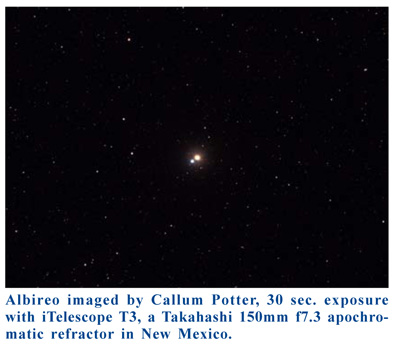Some colourful double stars for the summer months
2015 May 29
 As we run towards mid-summer many deep sky observers take the opportunity for a couple of months off, and look to some summer equipment maintenance, or just put their feet up and watch the cricket or tennis. Indeed the short nights and a lack of proper darkness over many parts of the UK make searching out faint fuzzies difficult.
As we run towards mid-summer many deep sky observers take the opportunity for a couple of months off, and look to some summer equipment maintenance, or just put their feet up and watch the cricket or tennis. Indeed the short nights and a lack of proper darkness over many parts of the UK make searching out faint fuzzies difficult.
However, it can be a good time to do some double-star observing, where the lack of astronomical darkness is not a huge barrier. I have to say I am not a ‘serious’ double-star observer but I do enjoy viewing double stars, and in particular those with interesting colours or colour contrasts.
Beta Cygni – Albireo – is perhaps my favourite double star, a deep blue and yellow jewel in the sky. The brighter star is the yellow component, at around magnitude 3.1 with the dimmer blue star at magnitude 5. You can get an idea about the colours of the stars by checking their spectral type. The yellow star is type K2 and the blue is B8. The pair lie around 430 light years from us.
Delta Lyrae is not a true binary pair, but nevertheless makes an interesting double. Delta-1 is a mag 5.5, B2 star, and quite clearly blue. Delta-2 is mag 4 and type M4 with an orange hue. Both stars seem to be embedded in the open cluster Stephenson 1, though probably only Delta-2 is an actual cluster member.
Alpha Herculis – Rasalgethi – is the brightest ‘star’ in the constellation of Hercules, and is a somewhat tighter double than the previous objects (four arcseconds separation). The double comprises a red giant (M5) and a blue-green companion. In fact the companion is itself a binary system of type G5 + F2.
70 Ophiuchi is a relative neighbour of ours in space, at only 16.6 light years distant. The primary is a type K0 yellow-orange star, and the secondary is K4 orange. The two stars are in a highly elliptical orbit, and the period is only about 84 years, so our youngest members might be able to observe a complete orbit in their lifetimes.
Alpha Piscium – Alresca – is a little low in the east before dawn in June but will be better placed in July and August. This is an even tighter pair at about 1.3 arcseconds separation. The two stars are not such different spectral types, A0 and A3, so you might not expect to see much difference between these ‘white’ stars, but contrast effects may make them seem more coloured. It would be interesting to hear from observers how they see this pair.
Gamma Andromedae – Almach – is another yellow/blue pair. The brighter, yellow (K3), component is mag 2.2 and the dimmer, blue (B9) companion is around mag 4.8. The pair are separated by around ten arcseconds so easy to split.
Gamma Arietis – Mesarthum – is a white star pair with a separation of about 8 arcseconds. Again although of similar spectral type and brightness it is interesting to see if you notice any colour differences between the two. In fact the marginally fainter component is of type Ap a ‘peculiar’ star – and the primary B9.
Beta Delphini has the ‘proper’ name Rotanev, but this was coined only in the early 19th century to honour the astronomer Nicolaus Venator (Rotanev is Venator spelled backwards). It is a rather tight double with separation of around 0.44 arcseconds and will be a challenge for many observers. They are both yellow-white of type F5 and have a combined apparent magnitude of around 3.6.
I hope that making a start at observing interesting colour contrast doubles may pique your interest in double-star observing. The Deep Sky Section would welcome reports of observations made. The Section has a double-star advisor, John McCue, who will be happy to provide advice on stars to observe, and measurement techniques.
Callum Potter, Director, Deep Sky Section
| The British Astronomical Association supports amateur astronomers around the UK and the rest of the world. Find out more about the BAA or join us. |
